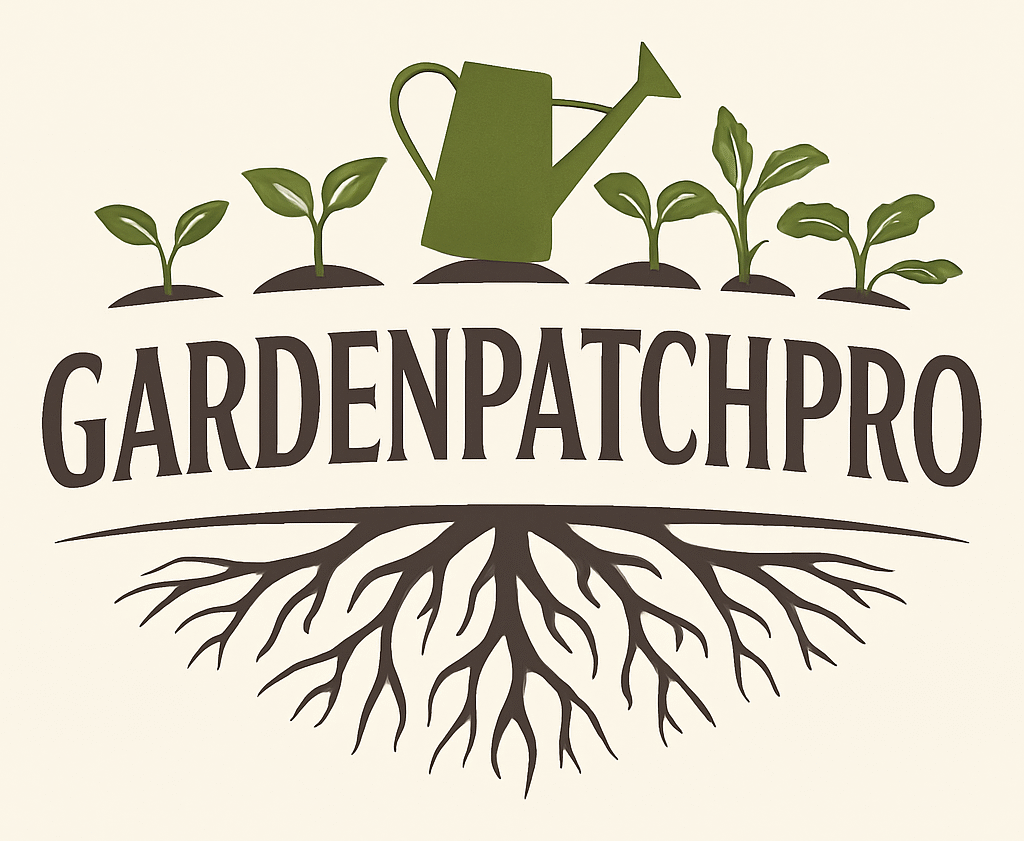13 Cherry Blossom Garden Ideas to Transform Your Outdoor Space
Cherry blossom gardens are a popular choice for adding beauty and tranquility to outdoor spaces. These gardens bring soft colors and a peaceful atmosphere, making them ideal for many types of landscapes.

The key to creating a successful cherry blossom garden is thoughtful design that balances color, texture, and plant placement to enhance visual appeal. With careful planning, a cherry blossom garden can fit well in both traditional and modern settings, offering year-round interest and charm.
1) Plant Yoshino cherry trees for classic white blossoms
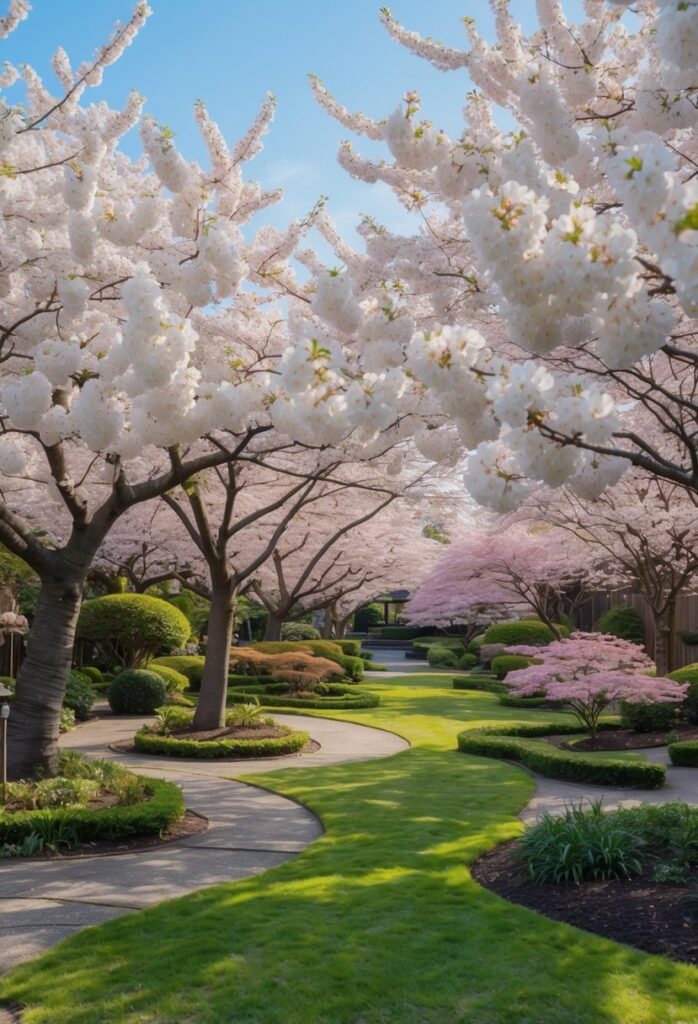
The Yoshino cherry tree is famous for its beautiful white to pale pink flowers. It is a popular choice in many cherry blossom gardens because of its classic and elegant look. The tree blooms in early spring, creating a stunning display.
Yoshino cherry trees grow best in full sun and well-drained soil. They reach about 20 feet tall and wide, making them great for providing shade as well as beauty. Their broad, rounded shape fits well in gardens of many sizes.
This tree is native to Japan and is often seen at cherry blossom festivals. It has a subtle almond scent that adds to the sensory experience of a garden. Proper planting and care help ensure it flourishes with abundant blossoms. Learn more about planting and caring for Yoshino cherry trees at How to Plant, Grow and Care for Yoshino Cherry Tree – Full Guide.
2) Use Kwanzan cherry trees for vibrant pink flowers
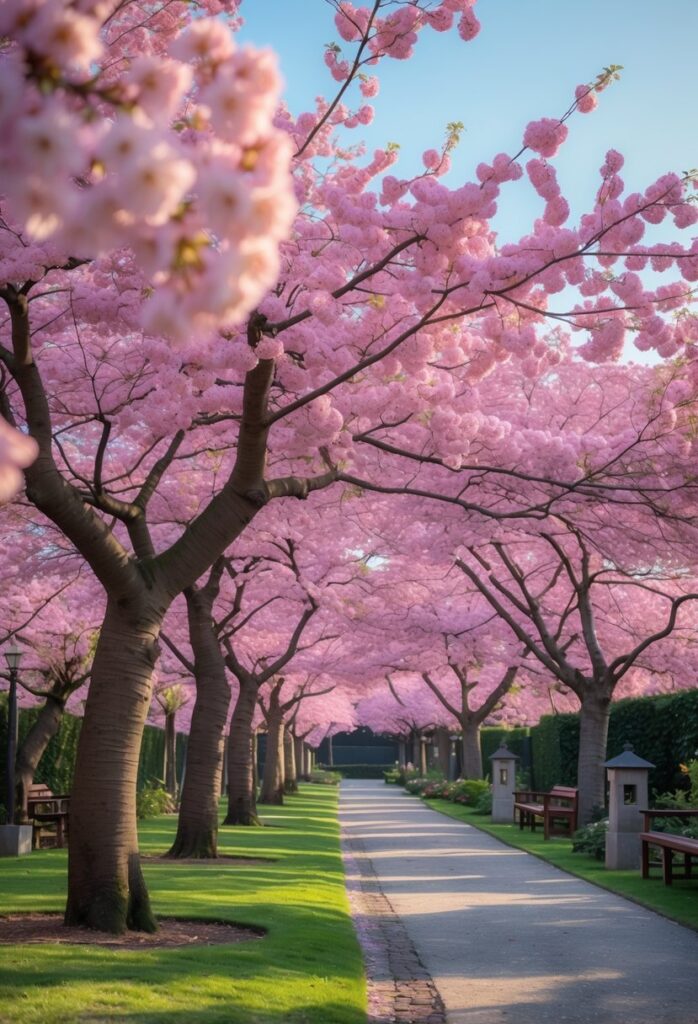
Kwanzan cherry trees are known for their deep pink, double-petaled flowers. These blooms appear in mid to late spring, adding a bold splash of color to any garden.
The tree grows to about 36 feet tall with a wide, spreading canopy. Its flowers cluster in groups, creating a full and vibrant display that stands out among other trees.
Kwanzan cherries are fast-growing and hardy. They tolerate different soil types well and can handle urban conditions better than many flowering trees.
Gardeners often prune Kwanzan trees to maintain their vase-like shape. This helps keep the tree healthy and encourages more abundant blooming.
Planting several Kwanzan cherry trees in a row can create a striking flowering fence. Their pink flowers bring a strong visual impact across larger spaces.
These trees also have ornamental bark and leaves that change color, adding interest beyond the spring blooming season.
For more details on growing Kwanzan cherry trees successfully, see this Kwanzan Cherry Tree Guide.
3) Incorporate dwarf cherry varieties for small spaces
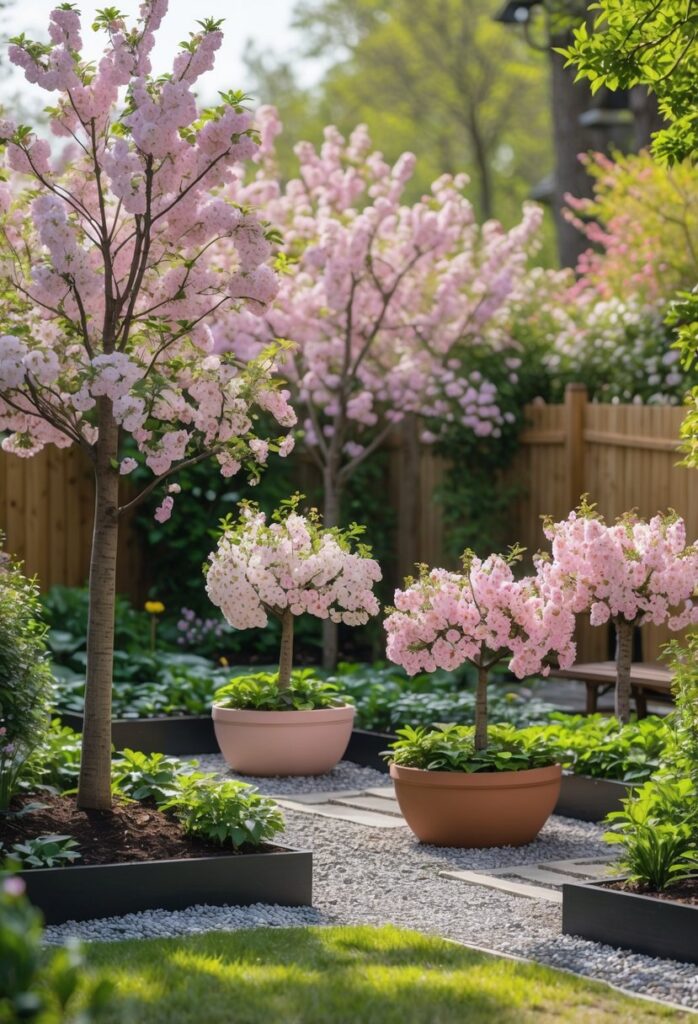
Dwarf cherry trees are ideal for gardens with limited space. They grow much smaller than standard cherry trees, usually reaching only 4 to 10 feet tall. This compact size makes them perfect for patios, balconies, or small yards.
These trees still produce beautiful blossoms, often pink or white, that add color in the spring. Some varieties also bear sweet fruit, making them both decorative and useful.
Dwarf cherries need less maintenance than larger trees. They are easier to prune and protect during winter. Many dwarf varieties are self-pollinating, so only one tree is needed for fruit.
Choosing dwarf cherry trees lets gardeners enjoy the charm of cherry blossoms without the space or care challenges of full-sized trees. For guidance on types and care, one can explore resources about the best dwarf cherry trees for small gardens.
4) Create cherry blossom pathways for serene garden walks
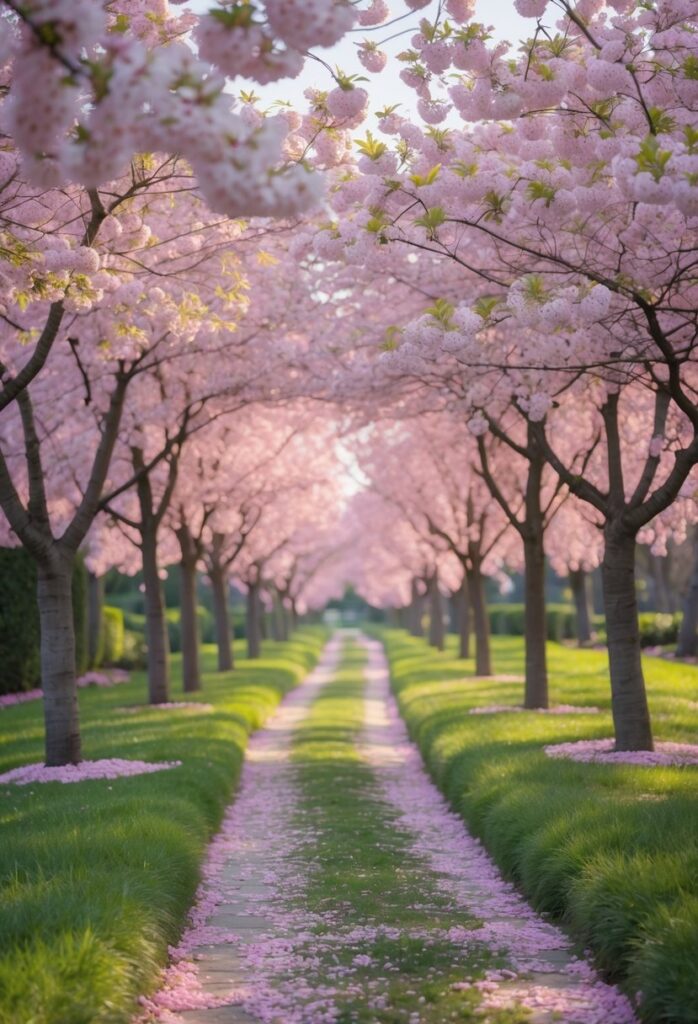
Cherry blossom pathways add a calm and peaceful feel to any garden. They invite people to walk slowly and enjoy the beauty of the blooms above and around them. This creates a natural tunnel of flowers that changes with the seasons.
Choosing the right cherry trees is important. Dwarf varieties work well in smaller spaces, while standard trees suit larger gardens. Proper spacing helps the trees grow evenly and keeps the pathway clear.
Adding stepping stones or a natural ground cover under the trees enhances the experience. These features guide visitors and add rhythm to the walk. Seating nearby offers a quiet spot for rest and reflection.
Positioning the trees carefully can increase privacy and reduce noise. It also helps create a tranquil outdoor space. Cherry blossom pathways can transform a garden into a place of gentle beauty and calm. For design ideas, see this guide on creating cherry blossom pathways.
5) Combine cherry trees with flowering perennials for contrast

Pairing cherry trees with flowering perennials adds color and texture to the garden. The soft blooms of the cherry trees stand out against the vibrant flowers of perennials.
Perennials like hosta, ajuga, and spotted deadnettle work well under cherry trees. These plants can thrive in shade and create a layered look that complements the tree’s branches.
Flowering perennials also help keep the soil healthy and reduce weeds. Their roots fill the ground, making the garden more stable and easier to manage.
Using perennials that bloom at different times gives the garden interest throughout the year. This creates a dynamic space that changes with the seasons.
Combining cherry trees with perennials brings balance. The tree offers height while the perennials provide ground-level color and shape, improving the overall garden design.
More ideas on this combination can be found at Best/Worst Plants Under Cherry Trees + Landscaping Ideas!.
6) Use container gardens to grow cherries on patios

Cherry trees can grow well in containers, making them a good option for patios or small outdoor spaces. Using pots allows someone to enjoy fresh cherries without needing a large yard.
It is important to choose a large container with good drainage. The soil should be loose and well-drained to avoid water buildup. Overwatering can cause problems, so keeping the soil moist but not soggy is key.
Selecting dwarf or patio-friendly cherry varieties works best in containers. Some varieties can self-pollinate, but planting more than one tree can help increase fruit production.
Regular care includes watering, mulching, and fertilizing the tree. Pruning helps the tree stay healthy and maintain its shape. Container cherry trees may also need some protection in cold weather.
A cherry tree in a pot can add beauty with its blossoms, as well as provide fruit. This method suits people who want to grow cherries but have limited space or live in urban areas. For more details, see growing cherry trees in containers.
7) Add seasonal ground cover beneath cherry trees
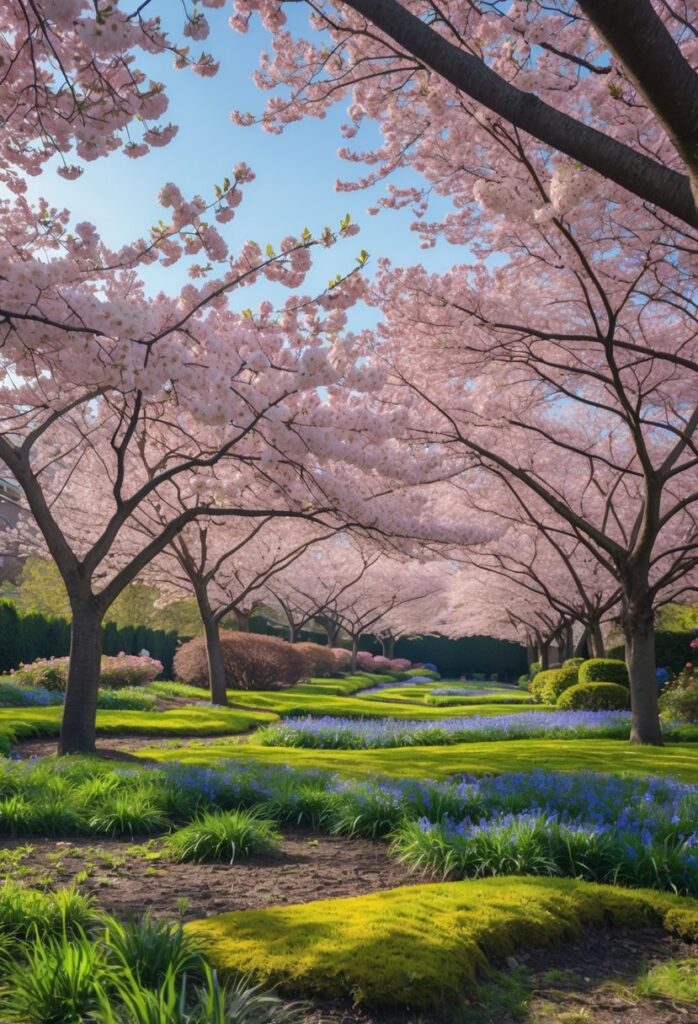
Adding seasonal ground cover under cherry trees helps protect the soil and keeps the area looking neat. These plants can fill space and add color during different times of the year.
Shade-loving perennials work well because cherry trees create a shady area with their canopy. Plants like ajuga, hosta, and spotted deadnettle are good choices. They have low roots that won’t harm the tree.
Bulbs such as crocus or daffodils also make great seasonal ground cover. They bloom in spring, creating a beautiful carpet of color around the tree as the cherry blossoms fall.
Using ground cover that stays green or flowers in different seasons brings year-round interest. Mulching around the roots helps keep the soil moist and protects both the tree and the smaller plants.
For more ideas on suitable plants and planting tips, see options for ground cover under cherry trees and how to plant ground cover under a tree.
8) Design spring borders with mixed cherry species
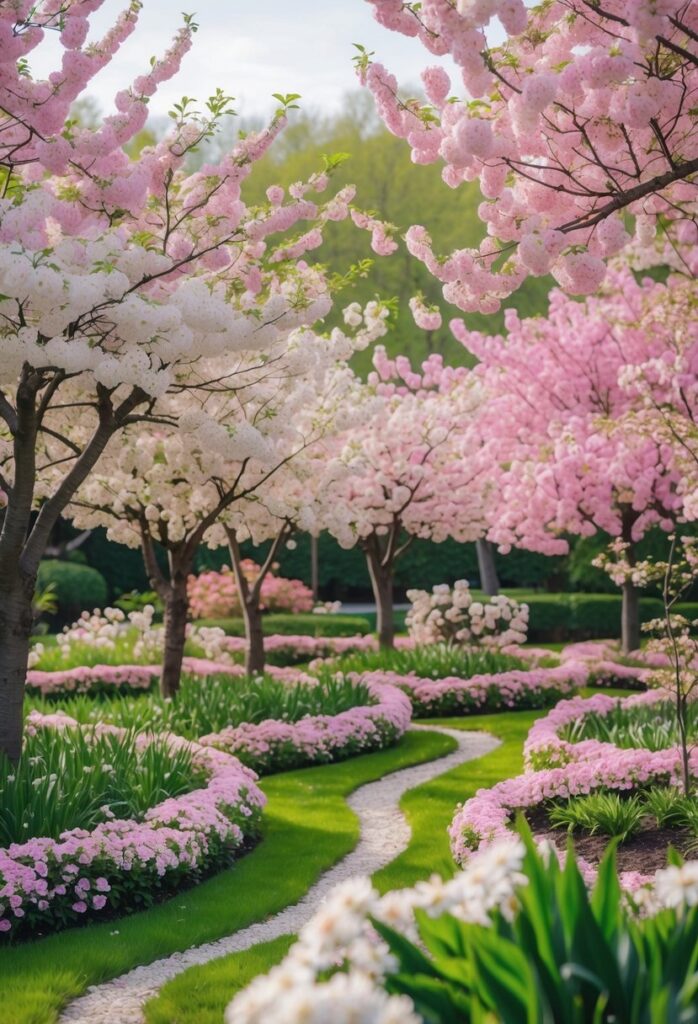
Using different cherry species in a spring border adds variety in color and shape. Some cherry trees have bright pink blossoms, while others show soft white flowers. Mixing these creates a lively and natural look.
Layering small and large cherry trees helps build depth. Smaller species can go near pathways, while taller ones form a background. This also allows for year-round interest when combined with other plants.
Choosing species with different bloom times extends the flowering season. Early bloomers start the display, and later ones keep the border colorful longer. This gives a more dynamic and changing garden.
Adding shrubs and ground covers that stay green all year makes the border fuller. This keeps the area attractive beyond spring. A mixed cherry border works well in different garden styles and sizes.
For more tips on how to create a vibrant shrub and cherry border, see this guide on mixed shrub borders.
9) Use mulch to enhance soil moisture and tree health
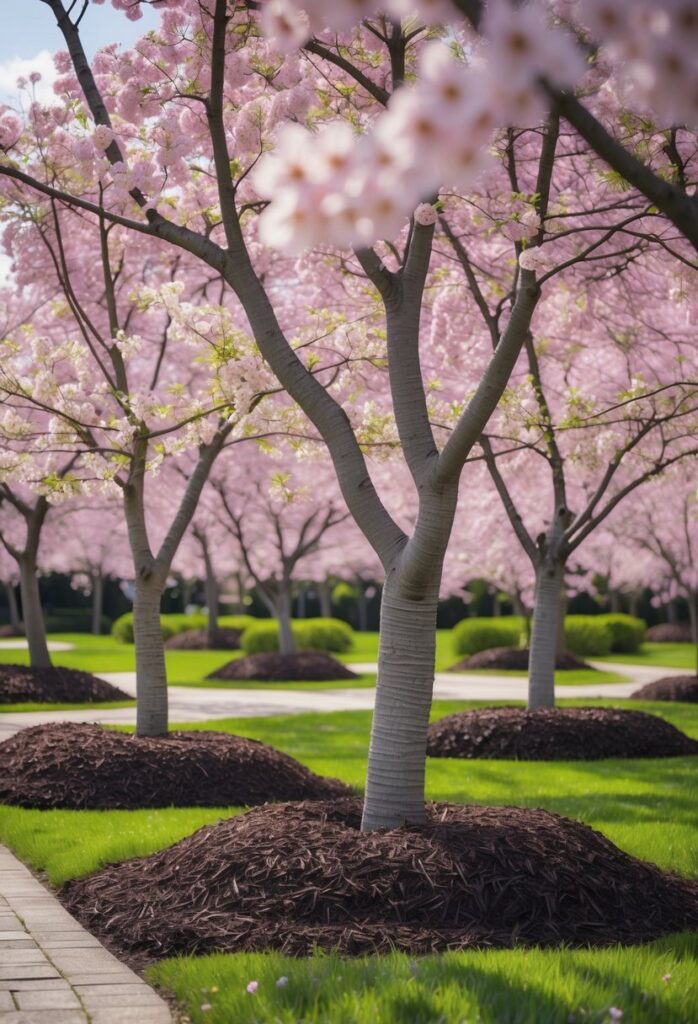
Mulch helps keep the soil around cherry blossom trees moist by reducing water evaporation. This is important during dry periods to keep the roots hydrated and support healthy growth.
It also helps control weeds by blocking sunlight, which stops unwanted plants from growing near the tree. Fewer weeds mean less competition for water and nutrients.
Applying mulch in a 2 to 4 inch layer around the base of the tree is best. However, it is important to leave a small gap between the mulch and the trunk to avoid moisture buildup that can cause rot.
Organic mulches, like shredded bark, leaves, or compost, slowly break down and add nutrients to the soil. This improves soil fertility and helps the tree grow stronger.
Mulching also keeps soil temperature steady. It protects roots from extreme heat in summer and cold in winter, helping the tree survive changing weather conditions.
For more details on mulching best practices, see the guide on best mulch for cherry trees.
10) Incorporate bird-friendly plants to attract fauna

Adding bird-friendly plants to a cherry blossom garden helps attract birds and other wildlife. These plants provide food, shelter, and nesting spots, making the garden a lively place.
Shrubs with berries, nectar-rich flowers, and native plants support different bird species. For example, berry-filled bushes offer food while dense shrubs give safe hiding places.
Using native plants is important because they attract local birds naturally. They also support insects that birds need to feed their babies.
Plants like serviceberry, elderberry, and dogwood work well with cherry blossoms. Flowering plants like bee balm and columbine add color and nectar for hummingbirds and songbirds.
Including a variety of plants creates a balanced habitat. This encourages a range of birds to visit throughout the year, not just in bloom season.
More ideas to attract birds can be found in this guide on 13 plants that attract birds in the South.
11) Create DIY cherry blossom decorations for festive touch
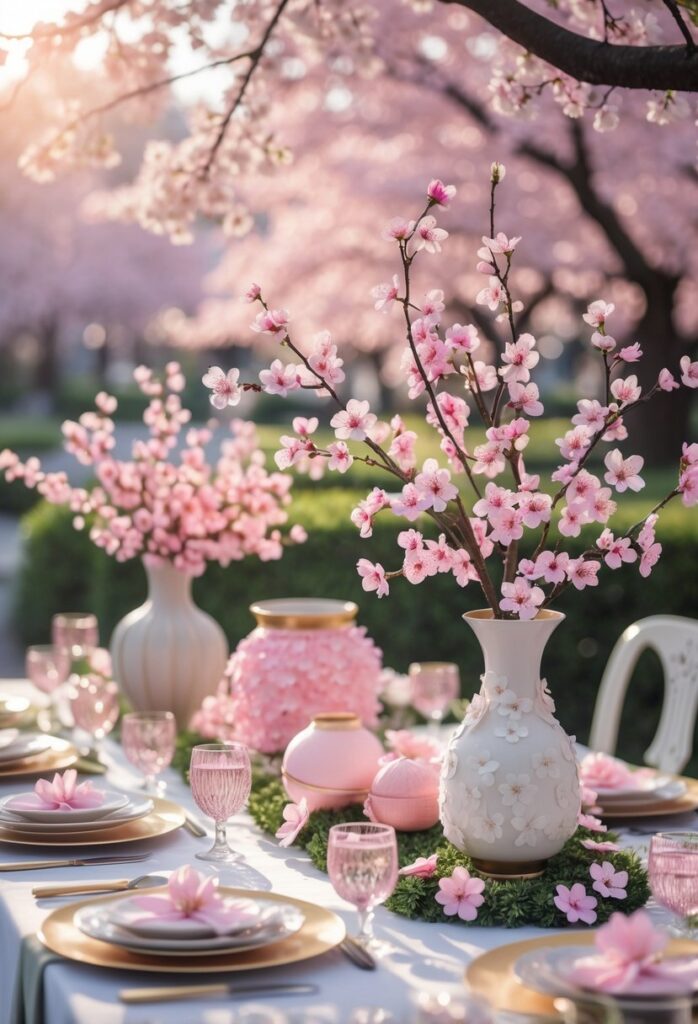
DIY cherry blossom decorations add a soft, natural feel to any garden party or celebration. They brighten spaces with delicate pink and white flowers without needing real blossoms.
Using simple materials like tissue paper, fabric, or recycled newspapers, anyone can craft beautiful cherry blossom branches. These decorations can be shaped and arranged on trees, tables, or walls for a festive look.
Creating these crafts is budget-friendly and allows for a personal touch. They are perfect for seasonal events and can bring spring indoors or outdoors. For ideas on making paper cherry blossoms, exploring DIY cherry blossom ideas can help.
These decorations also work well as centerpieces when made into faux cherry blossom trees using branches from the garden. This adds elegance while keeping the setup simple.
Overall, DIY cherry blossom decorations are a practical way to add charm and color to garden events or home celebrations.
12) Prune cherry trees annually to maintain shape and bloom

Pruning cherry trees every year helps keep their shape neat and encourages healthy blooms. It removes dead or crowded branches, allowing sunlight and air to reach all parts of the tree. This promotes stronger growth and better flowering.
The best time to prune ornamental cherry trees is usually in late winter or early spring, before new growth begins. Avoid heavy pruning during the growing season to prevent stress and fewer flowers.
Regular pruning can also reduce the risk of disease by improving air circulation. It helps control the tree’s size so it fits well in the garden. Using clean, sharp tools makes the cuts healthier for the tree.
For more details on pruning techniques and timing, see the guide on how to prune cherry blossom trees for beautiful blooms every year.
13) Plant cherry trees in full sun for optimal growth
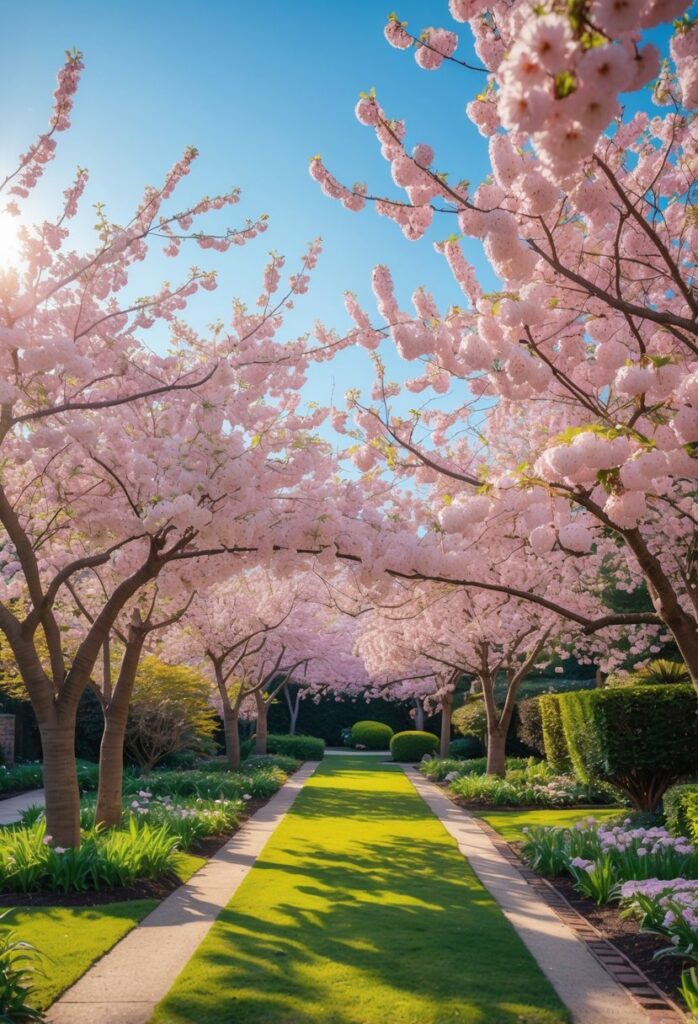
Cherry trees need plenty of sunlight to grow well. They do best with at least 6 to 8 hours of direct sun each day. This helps them produce more flowers and fruit.
Full sun also helps keep the tree healthy. Sunlight dries the leaves and branches after rain, which reduces the chance of diseases. It also warms the tree in spring, helping it start growing earlier.
Choosing a sunny spot, like a south-facing slope, gives cherry trees the best chance to thrive. Avoid planting in shady or low areas where sunlight is limited. This is important for both the tree’s growth and the beauty of its blossoms.
For more details on sunlight needs for cherry trees, see this guide on sun needs of cherry trees.
Cherry Blossom Care Essentials
Cherry blossom trees need specific conditions to grow well. Proper soil, sunlight, watering, and feeding help them stay healthy and produce beautiful blooms.
Soil and Sunlight Requirements
Cherry blossom trees grow best in well-draining soil that is fertile and slightly acidic, with a pH between 6.0 and 7.0. Soil that retains too much water can cause root problems and harm the tree.
The location should get full sun to partial shade. Ideally, the tree gets at least 6 hours of direct sunlight each day. Too little sun can reduce flowering. It is also important to give the tree enough space—around 10 to 20 feet from other plants—to ensure airflow and prevent disease.
Shelter from extreme winds and harsh weather supports healthy growth. Choosing a spot that avoids heavy heat and freezing cold will increase the tree’s chance of thriving.
Watering and Fertilization Best Practices
Cherry blossom trees require deep watering, especially during dry periods. Watering once a week is usually enough, but this can vary depending on soil type and climate. Overwatering should be avoided as it can lead to root rot.
Fertilize the tree in early spring and again in late fall with a balanced, slow-release fertilizer. Avoid over-fertilizing, which can cause weak growth and fewer flowers. Mulching around the base helps keep soil moist and controls weeds, but it should not touch the tree trunk. Proper watering and feeding promote strong roots and vibrant blossoms.
For more detailed care tips, visit this cherry blossom tree care guide.
Design Principles for Cherry Blossom Gardens
Cherry blossom gardens focus on balance and harmony through plant choices and timing. Proper color matching and smart companion planting enhance the cherry trees’ beauty. Planning for changes in bloom and foliage keeps the garden appealing throughout the year.
Color Coordination and Companion Planting
Choosing plants that complement the pink or white cherry blossoms is key. Soft greens, whites, and pastels work well. Shrubs like azaleas or hydrangeas add layers without overpowering the cherry trees.
Using dwarf or low-growing plants helps maintain visibility and highlights the blossoms. For example:
- Hostas and ferns under trees add texture and contrast
- Early spring bulbs like daffodils or tulips bring bright pops of color
- Ground covers such as creeping thyme keep soil neat and green
Proper spacing prevents crowding and allows sunlight to reach all plants. This means selecting companions that share similar water and light needs with cherry trees.
Creating Seasonal Visual Interest
A key design goal is to make the garden attractive beyond the cherry blossom season. Pairing blossoms with spring bulbs extends color from early spring into late spring.
Later, trees with interesting bark or autumn leaf color take over. Examples include:
- Planting dogwoods for summer blooms after cherry blossom fades
- Adding maples for striking fall leaves
- Including evergreens for winter structure and greenery
Using a mix of plants with staggered peak periods creates year-round appeal. This careful timing keeps the garden from looking empty outside the short cherry blossom bloom.
For more detailed landscaping tips, explore cherry blossom landscaping hacks.
Frequently Asked Questions
Cherry blossom gardens can fit into various spaces and styles. Choosing the right tree type, companion plants, lighting, and maintenance plan helps create a balanced and attractive garden. There are ways to design these gardens that fit different budgets and make the most of seasonal changes.
How can I incorporate cherry blossoms into a small garden space?
Using dwarf cherry tree varieties is ideal for smaller gardens. These trees take up less room but still provide beautiful blooms. Planting them near pathways or in containers also saves space while adding charm.
What companion plants pair well with cherry blossoms for a harmonious design?
Flowering perennials like azaleas or hostas work well with cherry trees. Their different shapes and colors create contrast without overpowering the cherry blossom’s delicate flowers. Ground covers can also add texture under the trees.
Which types of lighting are best to enhance a cherry blossom garden for evening ambiance?
Soft, warm LED lights placed around the tree trunks or pathways highlight the blossoms gently. String lights can add a cozy feel without being too bright. Lighting should enhance the natural beauty without causing glare.
What are some budget-friendly cherry blossom garden designs?
Focusing on a few Yoshino cherry trees for white blossoms keeps costs reasonable. Adding simple mulch pathways and native plants reduce maintenance and expenses. Using seeds or young saplings instead of mature trees cuts initial costs.
How should one maintain a cherry blossom garden throughout the seasons?
Pruning in late winter helps shape the trees and remove dead branches. Regular watering is important during dry spells, especially in spring. Mulching keeps roots cool and soil moist while reducing weeds.
What are effective landscaping techniques for a cherry blossom-themed garden?
Creating pathways lined with cherry trees offers a peaceful walk. Grouping trees by type, like Kwanzan for vibrant pink flowers, helps showcase different colors. Layering plants by height and bloom time adds depth and visual interest. For more ideas, see cherry blossom landscape tips.
